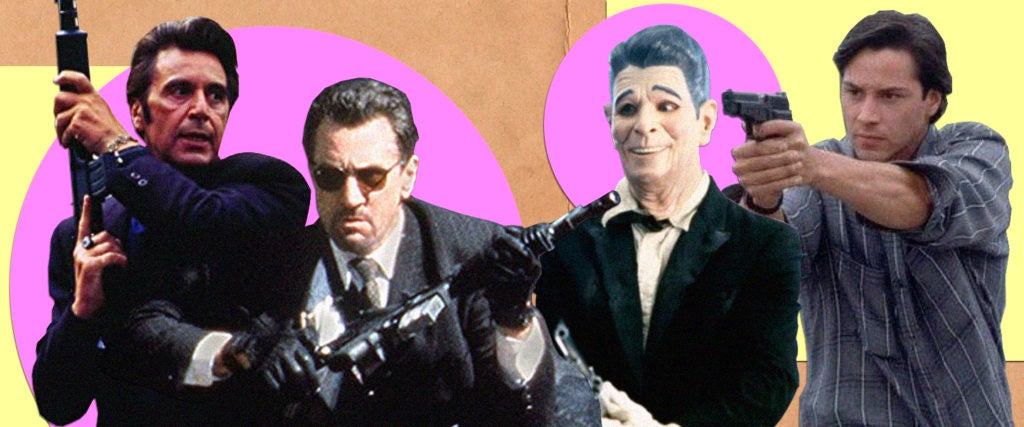The topic of representation in media comes up a lot in queer spaces, with debate about what’s accurate and what positively impacts the community happening regularly. And while there are more than a few gay films I’ve felt seen and understood by, I’ve also realized some of the best examples of homoerotic love and lust exists in movies that aren’t even technically gay. Two crime thrillers from the 1990s particularly stand out: Heat and Point Break, each of which is about a crew of bank robbers and the law enforcement trying to hunt them down.
Allow me to explain…
Heat (1995)
Neil McCauley (Robert De Niro) is a cutthroat criminal leading a crew of professional thieves running heists in L.A. Vincent Hanna (Al Pacino) is the LAPD robbery/homicide lieutenant leading the investigation to bring them to justice. But far from just a game of cat-and-mouse, the dynamic that forms between them is more akin to a dangerously flirtatious dance than a mano-a-mano battle.
Heat examines the two men’s private lives as much as their professional careers and shows exactly how the latter reflects on the former. Each is highly successful in their field and deeply dysfunctional in their relationships, completely unable to connect with the women in their lives.
Neil has a relationship with a woman named Eady, but can’t be honest with her about the violent way he makes his living, and is more than willing to walk out on her if ever he “feels the heat” coming around the corner. Meanwhile, Vincent’s third marriage is falling apart, largely because he can’t let go of his work enough to be present for his wife and step-daughter. He tells them they have to share him with “all the bad people in the world” that he can’t stop chasing.
Even on the most surface level, the rivalry between the two feels remarkably intimate, with a sense of deep mutual understanding that neither party is used to or comfortable with. That said, they keep each other at a distance for most of the film’s nearly three-hour runtime, with each surveillance, counter-surveillance, chase and retreat being part of the larger courtship between these two enemies. It all culminates in a scene where Vincent tails Neil, pulls right up to his car and then outright asks the robber/murderer if he can buy him a cup of coffee. Neil agrees.
Heat’s coffee scene is legendary for being the first time the Hollywood heavyweights acted opposite each other, and the chemistry they have is astounding. In a film full of violent, macho vignettes assuring us these two men are fated to clash, director Michael Mann subverts all expectations, and we have a moment of quiet among the chaos. It also happens to be one of the most charming first-date scenes in movie history.
Despite all attempts to be guarded and closed off, the two spark a remarkable connection, becoming unlikely confidants to each other. They bond over their dedication to the game, their troubled dreams and their unwillingness to compromise. Neither really knows how to live a regular life or how to be any way other than how they are, and both agree that they will murder the other if they get in their way. These two men feel they can’t commit to the women in their lives, but they can accept one another as they are. They complete each other in their own uncompromisingly masculine way.
The two only meet one other time during the film’s final chase scene that has its dueling protagonists awash in an ethereal stillness. In the end, one has to gun the other down as they’d previously predicted might happen, and while neither the survivor nor the dead man is happy about it, there’s a romantic serenity between the two as they hold each other’s hands and accept their losses.
Point Break (1991)
If Heat tells the story of a flirtation, then Kathryn Bigelow’s Point Break is a full-blown seduction. Rookie FBI agent Johnny Utah (Keanu Reeves) is after a group of extreme-sports-loving bank robbers called the Ex Presidents, but to bust them, he has to learn to surf so he can embed himself in their circle. And while Johnny learns to hang loose from a woman named Tyler (Lori Petty), the real connection he sparks is with the enigmatic and philosophical Bodhi (Patrick Swayze), who’s also Tyler’s ex-lover and the secret leader of the Ex Presidents.
Bodhi and his crew see surfing and other extreme sports as a way of life and a means to achieve euphoria, with one of them even referring to big-wave riding as a rush that surpasses sex. Similarly, Bodhi sees their crimes as just another extreme sport and a way to exist on a different plane, free from society’s standards and rules. It’s all just a fun ride to them.
Bigelow isn’t necessarily subtle about the erotic nature of the film. The camerawork tends toward ogling the beautiful faces and sculpted bodies of its male leads from its very opening scene, which intercuts Johnny taking target practice in the rain with a dripping, wet shirt and Bodhi riding the swells in a skintight rash guard. With all the pretty half-naked dudes in the Ex Presidents, Point Break feels like the X Games version of the vampiric, homoerotic temptation found in The Lost Boys.
While Petty’s character was meant to be a mutual love interest for two men, Swayze and Reeves have far more chemistry. Johnny’s gaze toward Bodhi is just as sexually charged, looking on in awe and infatuation the first time he sees the golden-haired Adonis make love to the waves. In turn, Bodhi finds himself enamored with the twinky rookie, wanting to enlist him into his crew. A mentor-and-pupil bond forms between them that becomes all the more complicated when Johnny realizes his crush is the leader of the bank robbers he’s looking for. When they learn they exist on opposite sides of the law, neither can bring himself to take the other out. Both of them got too close.
Point Break is all about chasing a thrill to the point that it’s dangerous, with the high of extreme sports and professional crime forming a clear allegory with the thrill of love and all-encompassing desire. Johnny makes stupid decisions because of his feelings for Bodhi and chases him to the point of destroying his own career. “I know, Johnny — you want me so bad it’s like acid in your mouth,” Bodhi says before one jumps out a plane to chase the other into the open air.
Maybe Johnny’s superior was right — maybe he is just young, dumb and full of cum.
The Chase
Heat and Point Break weren’t the first stories to feature a homoerotic game of cat-and-mouse between two adversaries on opposite sides of the law, but they’re definitely some of the best. Cruising, a 1980 film about a detective (Pacino again) searching for a serial killer by going undercover in the gay men’s leather scene, is of particular note in terms of its bluntness about the sexuality in its subject matter. I’ve seen people detect this trope in work that’s centuries old, too, like in the mental fencing between Sherlock Holmes and Dr. Moriarty, or Javert’s feverish chasing of Jean Valjean in Les Misérables. And more recently, TV shows like Killing Eve and Hannibal have been very outright about the romantic and sexual nature of the relationships at their center.
But why is chasing a master criminal so incredibly gay?
I think it’s because there’s a deep intimacy at the heart of these stories, often focusing on someone desperately trying to understand another person. The law enforcement characters in these stories are usually people who feel unfulfilled, lonely or overwhelmed because of their commitment to their work or the expectations in their personal lives. The criminal is a figure that denies society’s rules and norms, and the implied danger of trying to understand that is coming to reject normativity in the same way.
In a situation like that, what could be more appealing than being gay and doing crime?

